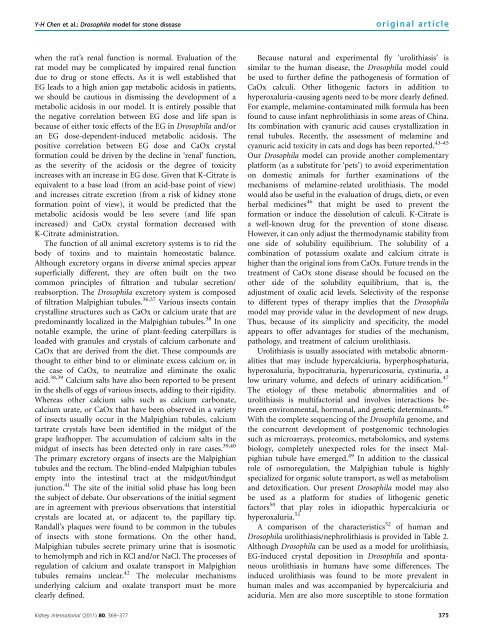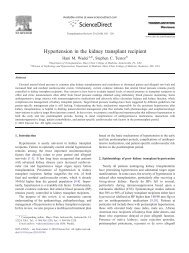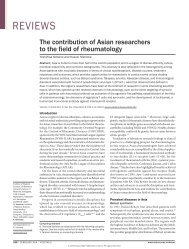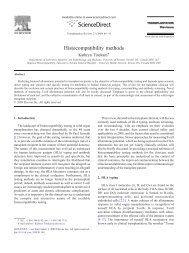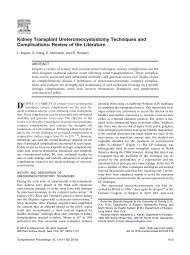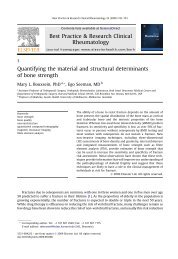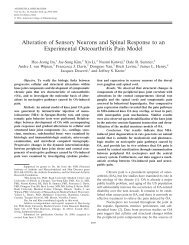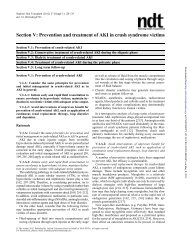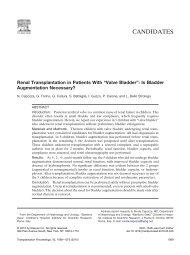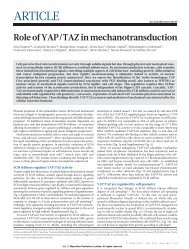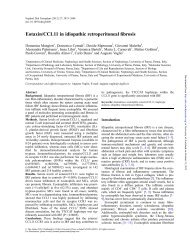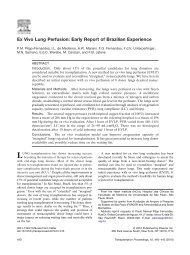Ethylene glycol induces calcium oxalate crystal deposition in ...
Ethylene glycol induces calcium oxalate crystal deposition in ...
Ethylene glycol induces calcium oxalate crystal deposition in ...
You also want an ePaper? Increase the reach of your titles
YUMPU automatically turns print PDFs into web optimized ePapers that Google loves.
Y-H Chen et al.: Drosophila model for stone disease<br />
orig<strong>in</strong>al article<br />
when the rat’s renal function is normal. Evaluation of the<br />
rat model may be complicated by impaired renal function<br />
due to drug or stone effects. As it is well established that<br />
EG leads to a high anion gap metabolic acidosis <strong>in</strong> patients,<br />
we should be cautious <strong>in</strong> dismiss<strong>in</strong>g the development of a<br />
metabolic acidosis <strong>in</strong> our model. It is entirely possible that<br />
the negative correlation between EG dose and life span is<br />
because of either toxic effects of the EG <strong>in</strong> Drosophila and/or<br />
an EG dose-dependent-<strong>in</strong>duced metabolic acidosis. The<br />
positive correlation between EG dose and CaOx <strong>crystal</strong><br />
formation could be driven by the decl<strong>in</strong>e <strong>in</strong> ‘renal’ function,<br />
as the severity of the acidosis or the degree of toxicity<br />
<strong>in</strong>creases with an <strong>in</strong>crease <strong>in</strong> EG dose. Given that K-Citrate is<br />
equivalent to a base load (from an acid-base po<strong>in</strong>t of view)<br />
and <strong>in</strong>creases citrate excretion (from a risk of kidney stone<br />
formation po<strong>in</strong>t of view), it would be predicted that the<br />
metabolic acidosis would be less severe (and life span<br />
<strong>in</strong>creased) and CaOx <strong>crystal</strong> formation decreased with<br />
K-Citrate adm<strong>in</strong>istration.<br />
The function of all animal excretory systems is to rid the<br />
body of tox<strong>in</strong>s and to ma<strong>in</strong>ta<strong>in</strong> homeostatic balance.<br />
Although excretory organs <strong>in</strong> diverse animal species appear<br />
superficially different, they are often built on the two<br />
common pr<strong>in</strong>ciples of filtration and tubular secretion/<br />
reabsorption. The Drosophila excretory system is composed<br />
of filtration Malpighian tubules. 36,37 Various <strong>in</strong>sects conta<strong>in</strong><br />
<strong>crystal</strong>l<strong>in</strong>e structures such as CaOx or <strong>calcium</strong> urate that are<br />
predom<strong>in</strong>antly localized <strong>in</strong> the Malpighian tubules. 38 In one<br />
notable example, the ur<strong>in</strong>e of plant-feed<strong>in</strong>g caterpillars is<br />
loaded with granules and <strong>crystal</strong>s of <strong>calcium</strong> carbonate and<br />
CaOx that are derived from the diet. These compounds are<br />
thought to either b<strong>in</strong>d to or elim<strong>in</strong>ate excess <strong>calcium</strong> or, <strong>in</strong><br />
the case of CaOx, to neutralize and elim<strong>in</strong>ate the oxalic<br />
acid. 38,39 Calcium salts have also been reported to be present<br />
<strong>in</strong> the shells of eggs of various <strong>in</strong>sects, add<strong>in</strong>g to their rigidity.<br />
Whereas other <strong>calcium</strong> salts such as <strong>calcium</strong> carbonate,<br />
<strong>calcium</strong> urate, or CaOx that have been observed <strong>in</strong> a variety<br />
of <strong>in</strong>sects usually occur <strong>in</strong> the Malpighian tubules, <strong>calcium</strong><br />
tartrate <strong>crystal</strong>s have been identified <strong>in</strong> the midgut of the<br />
grape leafhopper. The accumulation of <strong>calcium</strong> salts <strong>in</strong> the<br />
midgut of <strong>in</strong>sects has been detected only <strong>in</strong> rare cases. 39,40<br />
The primary excretory organs of <strong>in</strong>sects are the Malpighian<br />
tubules and the rectum. The bl<strong>in</strong>d-ended Malpighian tubules<br />
empty <strong>in</strong>to the <strong>in</strong>test<strong>in</strong>al tract at the midgut/h<strong>in</strong>dgut<br />
junction. 41 The site of the <strong>in</strong>itial solid phase has long been<br />
the subject of debate. Our observations of the <strong>in</strong>itial segment<br />
are <strong>in</strong> agreement with previous observations that <strong>in</strong>terstitial<br />
<strong>crystal</strong>s are located at, or adjacent to, the papillary tip.<br />
Randall’s plaques were found to be common <strong>in</strong> the tubules<br />
of <strong>in</strong>sects with stone formations. On the other hand,<br />
Malpighian tubules secrete primary ur<strong>in</strong>e that is isosmotic<br />
to hemolymph and rich <strong>in</strong> KCl and/or NaCl. The processes of<br />
regulation of <strong>calcium</strong> and <strong>oxalate</strong> transport <strong>in</strong> Malpighian<br />
tubules rema<strong>in</strong>s unclear. 42 The molecular mechanisms<br />
underly<strong>in</strong>g <strong>calcium</strong> and <strong>oxalate</strong> transport must be more<br />
clearly def<strong>in</strong>ed.<br />
Because natural and experimental fly ‘urolithiasis’ is<br />
similar to the human disease, the Drosophila model could<br />
be used to further def<strong>in</strong>e the pathogenesis of formation of<br />
CaOx calculi. Other lithogenic factors <strong>in</strong> addition to<br />
hyperoxaluria-caus<strong>in</strong>g agents need to be more clearly def<strong>in</strong>ed.<br />
For example, melam<strong>in</strong>e-contam<strong>in</strong>ated milk formula has been<br />
found to cause <strong>in</strong>fant nephrolithiasis <strong>in</strong> some areas of Ch<strong>in</strong>a.<br />
Its comb<strong>in</strong>ation with cyanuric acid causes <strong>crystal</strong>lization <strong>in</strong><br />
renal tubules. Recently, the assessment of melam<strong>in</strong>e and<br />
cyanuric acid toxicity <strong>in</strong> cats and dogs has been reported. 43–45<br />
Our Drosophila model can provide another complementary<br />
platform (as a substitute for ‘pets’) to avoid experimentation<br />
on domestic animals for further exam<strong>in</strong>ations of the<br />
mechanisms of melam<strong>in</strong>e-related urolithiasis. The model<br />
would also be useful <strong>in</strong> the evaluation of drugs, diets, or even<br />
herbal medic<strong>in</strong>es 46 that might be used to prevent the<br />
formation or <strong>in</strong>duce the dissolution of calculi. K-Citrate is<br />
a well-known drug for the prevention of stone disease.<br />
However, it can only adjust the thermodynamic stability from<br />
one side of solubility equilibrium. The solubility of a<br />
comb<strong>in</strong>ation of potassium <strong>oxalate</strong> and <strong>calcium</strong> citrate is<br />
higher than the orig<strong>in</strong>al ions from CaOx. Future trends <strong>in</strong> the<br />
treatment of CaOx stone disease should be focused on the<br />
other side of the solubility equilibrium, that is, the<br />
adjustment of oxalic acid levels. Selectivity of the response<br />
to different types of therapy implies that the Drosophila<br />
model may provide value <strong>in</strong> the development of new drugs.<br />
Thus, because of its simplicity and specificity, the model<br />
appears to offer advantages for studies of the mechanism,<br />
pathology, and treatment of <strong>calcium</strong> urolithiasis.<br />
Urolithiasis is usually associated with metabolic abnormalities<br />
that may <strong>in</strong>clude hypercalciuria, hyperphosphaturia,<br />
hyperoxaluria, hypocitraturia, hyperuricosuria, cyst<strong>in</strong>uria, a<br />
low ur<strong>in</strong>ary volume, and defects of ur<strong>in</strong>ary acidification. 47<br />
The etiology of these metabolic abnormalities and of<br />
urolithiasis is multifactorial and <strong>in</strong>volves <strong>in</strong>teractions between<br />
environmental, hormonal, and genetic determ<strong>in</strong>ants. 48<br />
With the complete sequenc<strong>in</strong>g of the Drosophila genome, and<br />
the concurrent development of postgenomic technologies<br />
such as microarrays, proteomics, metabolomics, and systems<br />
biology, completely unexpected roles for the <strong>in</strong>sect Malpighian<br />
tubule have emerged. 49 In addition to the classical<br />
role of osmoregulation, the Malpighian tubule is highly<br />
specialized for organic solute transport, as well as metabolism<br />
and detoxification. Our present Drosophila model may also<br />
be used as a platform for studies of lithogenic genetic<br />
factors 50 that play roles <strong>in</strong> idiopathic hypercalciuria or<br />
hyperoxaluria. 51<br />
A comparison of the characteristics 52 of human and<br />
Drosophila urolithiasis/nephrolithiasis is provided <strong>in</strong> Table 2.<br />
Although Drosophila can be used as a model for urolithiasis,<br />
EG-<strong>in</strong>duced <strong>crystal</strong> <strong>deposition</strong> <strong>in</strong> Drosophila and spontaneous<br />
urolithiasis <strong>in</strong> humans have some differences. The<br />
<strong>in</strong>duced urolithiasis was found to be more prevalent <strong>in</strong><br />
human males and was accompanied by hypercalciuria and<br />
aciduria. Men are also more susceptible to stone formation<br />
Kidney International (2011) 80, 369–377 375


